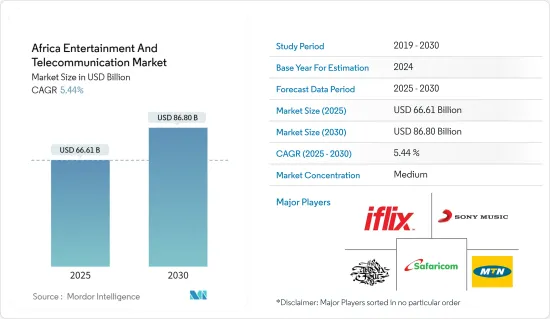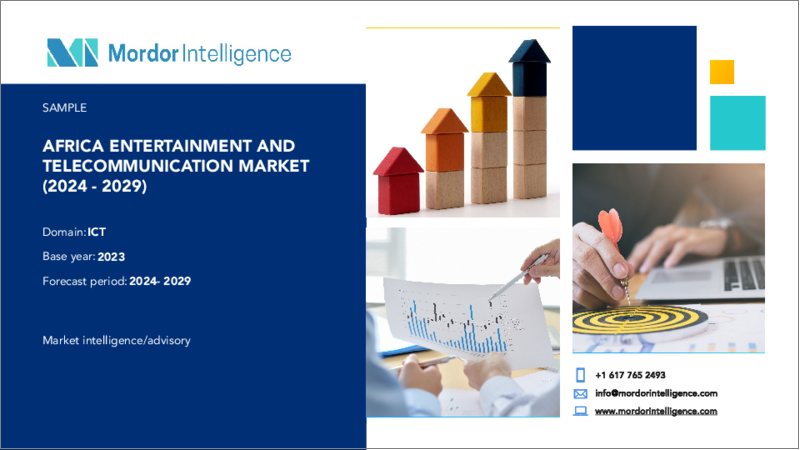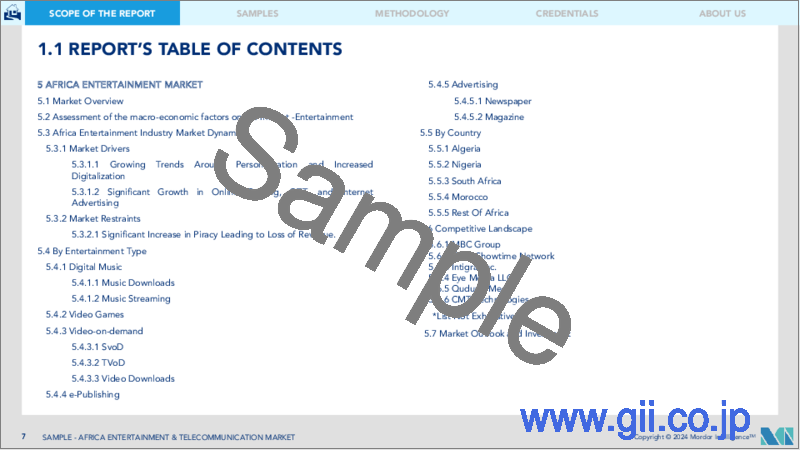|
|
市場調査レポート
商品コード
1643207
アフリカのエンターテインメントおよび通信:市場シェア分析、産業動向と統計、成長予測(2025年~2030年)Africa Entertainment And Telecommunication - Market Share Analysis, Industry Trends & Statistics, Growth Forecasts (2025 - 2030) |
||||||
カスタマイズ可能
適宜更新あり
|
|||||||
| アフリカのエンターテインメントおよび通信:市場シェア分析、産業動向と統計、成長予測(2025年~2030年) |
|
出版日: 2025年01月05日
発行: Mordor Intelligence
ページ情報: 英文 100 Pages
納期: 2~3営業日
|
全表示
- 概要
- 目次
アフリカのエンターテインメントおよび通信の市場規模は2025年に666億1,000万米ドルと推定され、予測期間(2025~2030年)のCAGRは5.44%で、2030年には868億米ドルに達すると予測されます。

アフリカのほとんどの市場でオンラインビデオ収益が増加すると予測されており、この地域のデジタル消費の伸びは世界最高水準にあります。若者の人口が多いこと、モバイル接続が急速に向上していること、新しいストリーミング・プラットフォームが市場に殺到していることが、この成長を後押しします。その結果、ビデオ収入に占めるデジタルの割合が増加し、アフリカのエンタテインメント市場が成長します。
主なハイライト
- アフリカは若年人口が急増しており、エンターテインメントおよび通信業界にとってユニークな市場促進要因となっています。若者の人口増加に伴い、エンターテインメント・コンテンツや通信サービスへの需要が高まっています。また、アフリカの中産階級の可処分所得水準が上昇していることも、エンターテインメントや通信サービスへの支出増加に寄与しています。
- 国連によると、アフリカの人口は世界で最も若く、人口の60%以上が25歳以下です。この若年層はエンターテインメント・コンテンツの熱心な消費者であり、新しい通信技術をいち早く採用するため、大きな市場促進要因となっています。モバイルデータ、ストリーミングサービス、ゲーム、ソーシャル・メディア・プラットフォームに対する需要は増加傾向にあり、このような消費者層の増加に対応する機会を産業界に生み出しています。
- アフリカ開発銀行の報告によると、アフリカの中産階級人口は拡大しており、可処分所得水準は大幅に上昇しています。この可処分所得の増加は、エンターテインメントや通信サービスへの支出の増加につながります。消費者は高品質のコンテンツ、モバイルデータプラン、ブロードバンド接続、付加価値サービスへの投資を厭わず、アフリカのエンターテインメントおよび通信市場の成長を牽引しています。
- モバイル技術の急速な拡大とデジタル変革も、アフリカ特有の市場促進要因です。モバイルの普及率は上昇傾向にあり、アフリカ大陸ではスマートフォンやモバイル機器がエンターテインメントや通信サービスへの主なアクセス手段となるモバイル・ファーストのアプローチが見られます。メディアや通信を含むさまざまな業界のデジタル変革が、革新的なコンテンツや接続ソリューションの需要を促進しています。
- さらに近年、アフリカ地域では、タワー会社とのモバイルタワーのセール・アンド・リースバック契約を通じて、通信事業者がアセットライト・モデルやMNVO(Mobile Virtual Network Operator)モデルへと移行するという動向の変化が見られます。一言で言えば、MVNOとは、顧客にサービスを提供するための無線ネットワーク・インフラを所有しない無線通信サービス・プロバイダーのことです。エアテルとMTNは、アフリカ地域でこの動向をリードしている2大通信サービス・プロバイダーの1つです。
- アフリカの多くの地域では、信頼性が高く手頃な価格のインターネット接続へのアクセスが依然として課題となっています。限られたブロードバンドカバレッジや不十分なネットワークインフラなどのインフラギャップが、インターネットサービスの拡大を妨げています。さらに、一部の地域ではデータ通信コストが高く、所得水準が低いため、人口の大部分にとってインターネット接続は手の届かないものとなっています。
- 国際通信連合(ITU)によると、2020年現在、アフリカのインターネット普及率は約39.3%です。これは前進を示す一方で、国や都市と農村の間でインターネット・アクセスに大きな差があるなど、アフリカ大陸内のデジタル・デバイドを浮き彫りにしています。インターネット接続が限られていると、インターネット接続に大きく依存するエンターテインメントや通信サービスの導入が阻害されます。
- 地域によっては、信頼できる電力供給や光ファイバー網など、適切な通信インフラが整備されていないため、インターネット接続の拡大が課題となっています。遠隔地やサービスが十分に行き届いていない地域では、インフラを拡張して信頼性の高いインターネット・サービスを提供することが難しく、コストもかかる地理的な障壁に直面することが多いです。このようなインフラの課題は、エンターテインメントや通信サービスに必要なインターネット接続の可用性と品質を阻害します。
- COVID-19は、社会的距離を置く措置や、映画館や劇場の閉鎖などの制限によって、デジタル・コンテンツやストリーミング・サービスの消費を大幅に増加させました。人々は家庭での娯楽を求め、映画、テレビ番組、音楽ストリーミング、その他の形態のデジタル・エンターテインメントの需要の増加につながった。
- さまざまなデジタル・プラットフォームは、パンデミックの間、ユーザーのエンゲージメントと導入が急増しました。例えば、Showmax、Netflix、Disney+といった国内外のストリーミング・プラットフォームは、アフリカでの視聴者数の増加を報告しました。これらのプラットフォームは、エンターテインメント・コンテンツに対する需要の高まりに対応し、映画、テレビ番組、ドキュメンタリー、オリジナル番組などを幅広く提供しました。また、ロシアとウクライナの戦争がエコシステム全体に与えた影響もあった。
アフリカのエンターテインメントおよび通信市場の動向
データアクセスとインターネット接続が成長を牽引
- アフリカの通信事業者は2018年以降、総契約数、デバイス所有率、インターネット普及率、データ使用量が増加し続けているため、緩やかではあるがプラス成長を遂げました。いつ、どこで、どのように好みのコンテンツに接するかについて、柔軟性、自由、利便性を重視する傾向が強まっていることが、この地域のエンターテインメントおよび通信産業の成長を牽引しています。GSMA State of Mobile Internet Connectivity 2022」レポートによると、サハラ以南のアフリカは、1GBのデータ通信料が1人当たり月間GDPに占める割合が2%を超える唯一の地域です。
- 低価格スマートフォンの普及と、3Gおよび4Gネットワークのカバレッジの向上が、データ接続の需要とデジタルサービスの利用を促進しています。固定無線や光ファイバー技術への投資も、同地域における固定ブロードバンドの普及を後押しします。
- 通信インフラの開発速度が速まることで、エンターテインメント業界にとっては、リーチの拡大や新規顧客の獲得という点で、より多くのビジネスチャンスが生まれると思われます。例えば、Internet World Statsによると、2021年12月にはアフリカの10人中4人程度がインターネットにアクセスしていました。
- デジタル行動の出現に伴い、サブスクリプション・モデルは、進化するテクノロジーを駆使したデジタル・プラットフォームの収益化において主要な役割を果たすようになり、それによってメディア・エンターテインメント業界の企業がより高い経営効率を達成する機会を生み出しています。例えば、2022年2月のDigital TV Researchでは、2021年末の489万件から2027年までに1,372万件のSVOD契約が増えると予測しています。アフリカにはAmazon Primeの対象国がないため、Amazon Prime Videoの有料加入者は2027年までに218万人になると予測されます。
- 地元企業、外国投資家、世界プレイヤーはいずれも、アフリカ大陸に多大な投資を行っています。国内でのインフラ共有、国境を越えた合併、国内での合併、規制や周波数帯や免許のオークションの機会に対応する政府などが、この地域の通信・エンターテインメント市場の成長に一役買っています。
スマートフォンで消費されるデータが大きな市場シェアを占める見通し
- アフリカは世界で唯一、若者の人口が増加している地域です。2050年までに、アフリカの若者、すなわち0歳から24歳までの人口は50%近く増加します。アフリカは最も多くの若者を抱えることになります。エンターテインメントや通信サービス全体の消費に関して、アフリカの若者はアフリカ大陸の将来にとって極めて重要です。スマートフォンを所有する人が急ピッチで増えていることから、スマートフォンは、さまざまな種類のエンターテインメントにアクセスするための最も便利なデバイスになりつつあります。
- ソーシャルメディアの出現は業界を混乱させ、プレーヤーは従来のプラットフォームからデジタル・プラットフォームへと切り替えつつあります。このような変化は、デジタル・メディアへの広告支出を増加させており、その結果、このセクターはデジタル・ツールやプラットフォームから多大な恩恵を受けています。こうしたシフトは、携帯電話を通じたコンテンツの効率的な制作、配信、消費を促進し、市場成長に革命をもたらしています。
- しかし、ソーシャルメディア利用、IP通信、あるいは一般的なデータ利用のためにアフリカ全土のインターネット・ユーザーに課される追加税や、税や規制をめぐるOTTプロバイダーと携帯電話事業者の対立が不公平な競争を招き、将来的にエンターテインメントおよび通信業界に悪影響を及ぼす可能性があります。
- 重要なSVODプレーヤーは、加入率を高め、消費者が低価格で好みの番組にアクセスできるようにする戦略の一環として、パック期間や小袋価格を導入しています。この動きは、価格に敏感な南アフリカ地域でOTTプラットフォームが大きく受け入れられるのに役立ちます。例えば、南アフリカのストリーミング市場のプレーヤーであるTelkomONEは、ワーナーメディア・ライブラリーのプレミアム・リニア・チャンネルとビデオ・オン・デマンド(VOD)コンテンツの追加を発表しました。アフリカ大陸トップのハリウッド映画専門チャンネル「Boing Africa」、差別のない若者向けのスーパーヒーロー・アクションの本場「TNT Africa」、14歳以下の子供向けの楽しさいっぱいのビデオ遊び場「Toonami Africa」など、ワーナーメディアの全チャンネルがストリーミング可能になった。
アフリカのエンターテインメントおよび通信業界の概要
メディア&エンタテインメント市場の競合情勢は激しく、業界をリードする有力プレーヤーで構成されています。市場シェアでは、現在いくつかの大手企業が市場を独占しています。しかし、OTTサービスにおける新たなネットワーク技術(5G)の進展に伴い、新たなプレーヤーが市場での存在感を高め、地域全体で事業基盤を拡大しています。
- 2023年10月-Sony Venturesは、Sony Innovation Fundを通じてアフリカのエンタテインメント新興企業に投資する1,000万米ドルのファンドを立ち上げた:アフリカ。このファンドはアフリカにおけるエンタテインメント・ビジネスの成長を支援します。
- 2023年7月- アフリカ全土の通信事業者であるMTNグループが、ナイジェリアに今後5年間で35億米ドル(650億ルピー)を投資することを決定。アフリカ最大のモバイル・ネットワーク・オペレーターであるMTNは、アフリカ全域での進歩のためのパートナーシップを呼びかけています。同社は、国家と進歩のために提携し、そのホスト国と志を共にしたいと考えています。
その他の特典:
- エクセル形式の市場予測(ME)シート
- 3ヶ月間のアナリスト・サポート
目次
第1章 イントロダクション
- 調査の前提条件と市場定義
- 調査範囲
第2章 調査手法
第3章 エグゼクティブサマリー
第4章 市場力学
- 市場概要
- 産業バリューチェーン分析
- 業界の魅力度-ポーターのファイブフォース分析
- 供給企業の交渉力
- 消費者の交渉力
- 新規参入業者の脅威
- 代替品の脅威
- 競争企業間の敵対関係
- 市場促進要因
- 可処分所得の増加
- テクノロジーとインターネット・ネットワーク・アクセスの向上
- 市場抑制要因
- 違法コピー、法規制、ゲーム取引中の不正行為に関する懸念などの問題
- COVID-19の業界への影響評価
第5章 市場セグメンテーション
- プラットフォーム別
- PC
- スマートフォン
- タブレット
- ゲーム機
- ダウンロード/ボックスPC
- ブラウザPC
- 地域別
- ナイジェリア
- エチオピア
- エジプト
- モロッコ
- ケニア
- アルジェリア
- ジンバブエ
第6章 競合情勢
- 企業プロファイル
- Gamesole
- Kuluya
- Chopup
- Kucheza
- Kagiso Interactive
- Nyamakop
- Celestial Games
- Clockwork Acorn
- Atos
- Arista Networks
- Broadcom Inc.
- Cisco Systems
- Dell Technologies
- Hewlett Packard Enterprise
- Huawei
- IBM Corporation
- NetApp
- Arup Group
- Callaghan Engineering
- Etix Everywhere
- Lupp Group
- ABB
- Eaton Corporation
第7章 投資分析
第8章 市場機会と今後の動向
The Africa Entertainment And Telecommunication Market size is estimated at USD 66.61 billion in 2025, and is expected to reach USD 86.80 billion by 2030, at a CAGR of 5.44% during the forecast period (2025-2030).

With most African markets projected to grow online video revenues, the region's digital consumption growth is among the highest in the world. A large youth population, fast-improving mobile connectivity, and a flood of new streaming platforms into the market will drive this growth. As a result, the digital share of the video revenue will increase, resulting in the growth of the entertainment market in Africa.
Key Highlights
- Africa has a young and rapidly growing population, which presents a unique market driver for the entertainment and telecommunication industry. With the increasing youth population, there is a growing demand for entertainment content and communication services. Additionally, rising disposable income levels among the middle-class population in Africa contribute to increased spending on entertainment and telecommunication services.
- According to the United Nations, Africa has the youngest population in the world, with over 60% of its population below the age of 25. This young demographic presents a significant market driver as the youth are avid consumers of entertainment content and early adopters of new telecommunication technologies. The demand for mobile data, streaming services, gaming, and social media platforms is on the rise, creating opportunities for the industry to cater to this growing consumer base.
- The African Development Bank reports that Africa's middle-class population is expanding, with a significant increase in disposable income levels. This rise in disposable income translates into increased spending on entertainment and telecommunication services. Consumers are willing to invest in high-quality content, mobile data plans, broadband connections, and value-added services, driving the growth of the entertainment and telecommunication market in Africa.
- The rapid expansion of mobile technology and digital transformation is another unique market driver in Africa. Mobile penetration rates are increasing, and the continent is witnessing a mobile-first approach, where smartphones and mobile devices are the primary means of accessing entertainment and communication services. The digital transformation of various industries, including media and telecommunications, is driving the demand for innovative content and connectivity solutions.
- Furthermore, in recent years, a shift in trend has been observed in the African region, wherein through the sale and leaseback agreements of mobile towers with tower companies, telcos are moving toward the asset-light or Mobile Virtual Network Operator (MNVO) model. In a nutshell, MVNOs are wireless communications services provider that does not own the wireless network infrastructure over which it provides services to their customers. Airtel and MTN are among the two major telco service providers leading the trend in the African region.
- In many parts of Africa, access to reliable and affordable internet connectivity remains a challenge. Infrastructure gaps, including limited broadband coverage and inadequate network infrastructure, hinder the expansion of Internet services. Additionally, high data costs and low-income levels in certain regions make internet access unaffordable for a significant portion of the population.
- According to the International Telecommunication Union (ITU), as of 2020, Africa's internet penetration rate stood at around 39.3%. While this indicates progress, it also highlights the digital divide within the continent, with significant variations in internet access between countries and urban-rural areas. Limited internet connectivity inhibits the adoption of entertainment and telecommunication services that heavily rely on internet access.
- In some regions, the lack of adequate telecommunications infrastructure, including reliable power supply and fiber-optic networks, poses challenges to expanding internet connectivity. Remote and underserved areas often face geographical barriers that make it difficult and costly to extend infrastructure and provide reliable internet services. These infrastructure challenges impede the availability and quality of internet connectivity required for entertainment and telecommunication services.
- COVID-19 restrictions, such as social distancing measures and the closure of cinemas and theaters, prompted a significant increase in the consumption of digital content and streaming services. People sought entertainment options at home, leading to a rise in the demand for movies, TV shows, music streaming, and other forms of digital entertainment.
- Various digital platforms experienced a surge in user engagement and adoption during the pandemic. For instance, local and international streaming platforms, such as Showmax, Netflix, and Disney+, reported increased viewership in Africa. These platforms catered to the growing demand for entertainment content, providing a wide range of movies, TV shows, documentaries, and original programming. There has also been an impact of the Russia-Ukraine war on the overall ecosystem.
Africa Entertainment And Telecommunication Market Trends
Data Access and Availability of Internet Access to Drive the Growth
- African telecommunications operators experienced positive, if muted, growth since 2018 as total subscriptions, device ownership, internet penetration, and data usage continue to increase. The increased emphasis on flexibility, freedom and convenience in when, where, and how they interact with their preferred content is driving the growth of the entertainment and telecommunication industry in the region. According to the GSMA State of Mobile Internet Connectivity 2022, report, Sub-Saharan Africa is the only region where the cost of 1GB of data as a percentage of monthly GDP per capita exceeds 2%.
- The increased availability of low-cost smartphones and improving coverage of 3G and 4G networks are driving the demand for data connectivity and the take-up of digital services. Investment in fixed wireless and fiber technologies will also help to drive the adoption of fixed broadband in the region.
- The increasing rate of development in the telecom infrastructure will create more opportunities for the entertainment industry in terms of better reach and new customer acquisitions. For instance, According to Internet World Stats, Around four out of 10 people in Africa had internet access in December 2021.
- With the emergence of digital behavior, subscription models are playing a primary role in the monetization of the digital platform with evolving technologies, thereby creating opportunities for companies in the media and entertainment industry to achieve greater operational efficiencies. For instance in February 2022 Digital TV Research forecasts 13.72 million SVOD subscriptions by 2027, up from 4.89 million at end-2021.Whereas Netflix will account for 47% of the region's SVOD subscriptions by 2027. With no Amazon Prime countries in Africa, Amazon Prime Video is forecast to have 2.18 million paying subscribers by 2027.
- Local companies, foreign investors, and global players have all made a significant investment in the continent. Domestic infrastructure sharing, cross border, and in-country mergers, and governments responding to the opportunity to regulate and to auction spectrum and licenses are some of the major factors playing a role in the growth of the telecommunication and entertainment market in the region.
Data Consumed through Smartphone Segment is Expected to Have Major Market Share
- Africa is the only region in the world where the youth population is increasing. By 2050 Africa's young people, i.e., those aged between 0 and 24 years old, will increase by nearly 50 percent. Africa will have the most significant number of young people. Africa's youth are critical to the continent's future when it comes to the consumption of entertainment and telecommunication services as a whole. Smartphones are becoming the most convenient devices to access various types of entertainment as the number of people owning a smartphone is increasing at a rapid pace.
- The emergence of social media is disrupting the industry and players are switching from traditional towards digital platforms, these changes are increasing their ads spend on the digital media due to which the sector is significantly benefitting from digital tools and platforms. Such shifts are facilitating efficient production, distribution, and consumption of content through mobile phones revolutionizing market growth.
- However, additional taxes imposed on internet users across Africa for social media use, IP communication, or just general data use and the turf between OTT providers and mobile operators over taxes and regulations resulting in unfair competition may negatively impact the entertainment and telecommunication industry in the future.
- Significant SVOD players are introducing pack durations and sachet pricing as part of their strategies to boost subscription rates and ensure that consumers can access preferred shows at a low cost. This move can help OTT platforms gain significant acceptance in the price-sensitive South Africa region. For example, TelkomONE, a player in South Africa's streaming market, announced the addition of premium linear channels and video-on-demand (VOD) content from the WarnerMedia library. All WarnerMedia channels, including Boing Africa, the continent's top dedicated Hollywood movie channel, TNT Africa, the home of superhero action for discriminating young people, and Toonami Africa, the fun-filled video playground for kids under 14, are now streamable.
Africa Entertainment And Telecommunication Industry Overview
The media & entertainment market landscape is highly competitive and consists of some of the prominent players leading across the industry. In terms of market share, some of the major players currently dominate the market. However, with the advancement in the emerging network technology (5G) across the OTT services, new players are increasing their market presence thereby expanding their business footprint across the region.
- October 2023 - Sony Ventures launched a USD10M fund to invest in African entertainment startups through the Sony Innovation Fund: Africa. This fund will support the growth of entertainment businesses in Africa.
- July 2023 - Pan-African telecoms provider MTN Group has set to invest USD 3.5 billion (R65 billion) in Nigeria over the next five years. Africa's largest mobile network operator, MTN, has been calling for partnerships for progress across Africa. The company wants to partner for progress with nation-states and twin its aspirations with its host countries.
Additional Benefits:
- The market estimate (ME) sheet in Excel format
- 3 months of analyst support
TABLE OF CONTENTS
1 INTRODUCTION
- 1.1 Study Assumptions and Market Definition
- 1.2 Scope of the Study
2 RESEARCH METHODOLOGY
3 EXECUTIVE SUMMARY
4 MARKET DYNAMICS
- 4.1 Market Overview
- 4.2 Industry Value Chain Analysis
- 4.3 Industry Attractiveness - Porter's Five Forces Analysis
- 4.3.1 Bargaining Power of Suppliers
- 4.3.2 Bargaining Power of Consumers
- 4.3.3 Threat of New Entrants
- 4.3.4 Threat of Substitutes
- 4.3.5 Intensity of Competitive Rivalry
- 4.4 Market Drivers
- 4.4.1 Rise in Disposable Income
- 4.4.2 Improvement in Technology and Internet Network Access
- 4.5 Market Restraints
- 4.5.1 Issues Such as Piracy, Laws and Regulations, and Concerns Relating to Fraud During Gaming Transactions
- 4.6 Assessment of Impact of Covid-19 on the Industry
5 MARKET SEGMENTATION
- 5.1 By Platform
- 5.1.1 PC
- 5.1.2 Smartphone
- 5.1.3 Tablets
- 5.1.4 Gaming Console
- 5.1.5 Downloaded/Box PC
- 5.1.6 Browser PC
- 5.2 By Geography
- 5.2.1 Nigeria
- 5.2.2 Ethipia
- 5.2.3 Egypt
- 5.2.4 Morocco
- 5.2.5 Kenya
- 5.2.6 Algeria
- 5.2.7 Zimbabwe
6 COMPETITIVE LANDSCAPE
- 6.1 Company Profiles
- 6.1.1 Gamesole
- 6.1.2 Kuluya
- 6.1.3 Chopup
- 6.1.4 Kucheza
- 6.1.5 Kagiso Interactive
- 6.1.6 Nyamakop
- 6.1.7 Celestial Games
- 6.1.8 Clockwork Acorn
- 6.1.9 Atos
- 6.1.10 Arista Networks
- 6.1.11 Broadcom Inc.
- 6.1.12 Cisco Systems
- 6.1.13 Dell Technologies
- 6.1.14 Hewlett Packard Enterprise
- 6.1.15 Huawei
- 6.1.16 IBM Corporation
- 6.1.17 NetApp
- 6.1.18 Arup Group
- 6.1.19 Callaghan Engineering
- 6.1.20 Etix Everywhere
- 6.1.21 Lupp Group
- 6.1.22 ABB
- 6.1.23 Eaton Corporation





